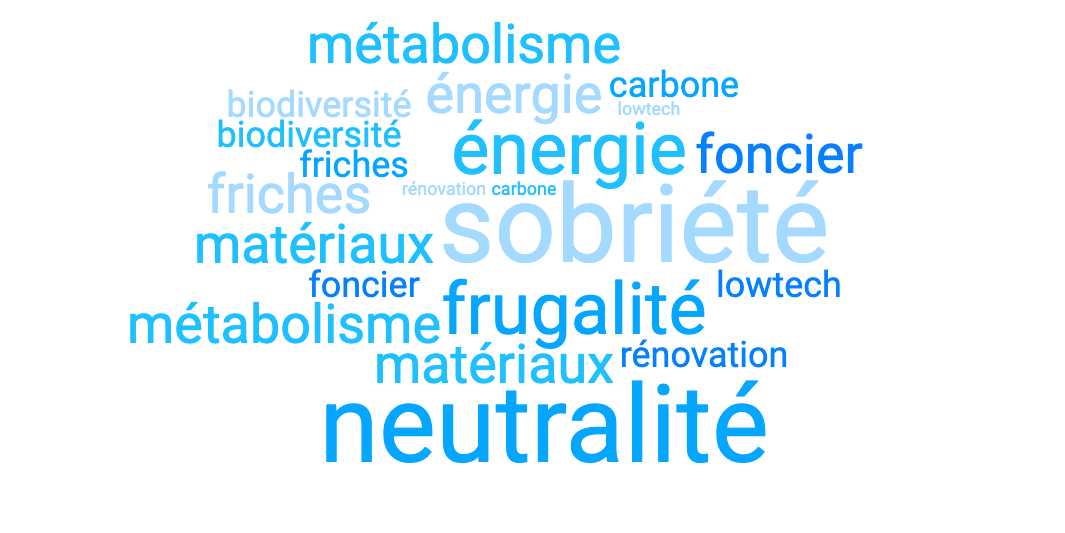Soberness, thriftiness, neutrality… Decoding the trendy words among city and real estate players.
ill consume and the higher its metabolism, i.e. the greater its need to supply resources.
Cities are also bulimic in terms of space, since the urban sprawl that has been a feature of urban planning and property development in recent decades has led to the transformation of tens of thousands of hectares of agricultural and natural land into roads, housing estates, industrial and commercial zones, etc.
Between the political support of certain initiatives and the launch of citizens’ movements, we are seeing the emergence of words that, while at first glance seem more like a communication strategy or greenwashing, are nonetheless meaningful for those who really want to put their money where their mouth is.
We have tried to decipher several of these trendy words:

Soberness in land use
In France, between 2011 and 2021, 243,000 hectares went from natural, agricultural or forest use to urban use, mainly for housing (67%) and economic activity (25%).
The Climate and Resilience Act of 22 August 2021 requires the consumption of space to be reduced by two within ten years and sets the obligation to achieve Zero Net Artificialization (ZAN) by 2050, which is a compensation measure.
The ZAN objective leads us to consider land as a natural resource to be preserved, in a triple context of climate change, the collapse of biodiversity and the challenge of food sovereignty.
Sobriety can be an opportunity to meet the new expectations of inhabitants and businesses, in balance with the maintenance of biodiversity and soil functions. Urban renewal, with the recycling of buildings or land and the densification of existing fabrics, can indeed help to reduce travel distances and develop services, local shops and public transport.
The elaboration of precise and shared land strategies must make it possible to anticipate the mobilisation of land and real estate wasteland within more ambitious and complex operations than the simple creation of housing estates on “bare” land.
Energy soberness
Becoming more energy efficient is a priority in industrialised countries where energy consumption levels have increased disproportionately over time. There are still populations in France and other countries who cannot access basic energy services such as heating, cooking or lighting.
In the negaWatt1 scenario, energy sobriety makes it possible to reduce our energy consumption by 28% in 2050 compared to 2015*. This tremendous potential is highlighted in the negaWatt scenario through several dozen quantified parameters such as transport, buildings, agriculture, industry, etc.
Carbon zero
Carbon neutrality is defined by the energy-climate law as “a balance, on the national territory, between greenhouse gas emissions and absorptions”. In France, achieving carbon neutrality by 2050 implies a division by 6 of greenhouse gas emissions on its territory compared to 1990.
In concrete terms, this means reducing France’s emissions to 80 MtCO2e from 458 MtCO2e in 2015 and 445 in 2018.
In the real estate sector, carbon neutrality is sought through life cycle analysis, which consists of analysing the impact in terms of CO2 emissions of a building at different levels and stages of development: production of materials, construction, operation, demolition.
Thriftiness
Thanks to natural ventilation, passive cooling, recovery of free heat and thermal inertia, bioclimatic design allows energy consumption to be reduced to a strict minimum, while ensuring greater comfort.
Wooden construction, long limited to individual houses, is now being used for large-scale public facilities and collective housing of more than 20 floors. Biobased insulation, marginal until recently, now accounts for almost 10% of the market and is growing by 10% each year.
Frugality in energy, raw materials, maintenance and upkeep leads to low tech approaches. This does not mean an absence of technology, but rather the use of relevant, adapted, non-polluting and wasteful techniques, such as equipment that is easy to repair, recycle and reuse. In both implementation and design, frugality requires innovation, invention and collective intelligence.
The “Manifesto for a happy and creative frugality”, jointly written by Dominique Gauzin-Müller, Alain Bornarel and Philippe Madec, explores this theme of frugality as an alternative to technicist and productivist visions, which are greedy for energy and resources of all kinds.
In the end, wouldn’t these words have more or less the same meaning? If so, they would not express the same degree of commitment, neutrality would be more akin to a compensation approach, whereas sobriety and frugality, which seem to be two very similar notions, are more in line with a reduction or even avoidance approach. Each project, each preliminary study, if we want to anticipate the environmental impact of a construction or a renovation, requires an ERC approach and thus to orient its action according to the Avoid-Reduce-Compensate scheme. Frugality advocates the use of the strict minimum, whereas sobriety is more akin to a reasoned and rational relationship with consumption.
–
1 The négaWatt Association is run by some twenty experts in energy issues – the Compagnie des négawatts – who have extensive field experience and complementary skills. Created in 2001, this association is now supported by more than 1200 members.
External links :
https://publications.cerema.fr/webdcdc/les-essentiels/sobriete-fonciere/
https://negawatt.org/IMG/pdf/sobriete-scenario-negawatt_brochure-12pages_web.pdf

